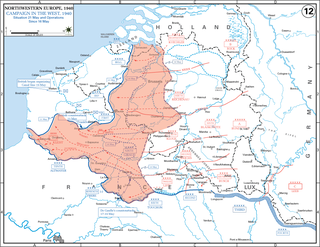 W
WThe Battle of Arras took place on 21 May 1940, during the Battle of France in the Second World War. Following the German invasion of the Low Countries on 10 May, French and British forces advanced into Belgium. The German campaign plan Fall Gelb had evolved into a decoy operation in the Netherlands and Belgium, with the main effort through the Ardennes. German units crossed the Meuse without waiting for reinforcements at the Battle of Sedan. Instead of consolidating bridgeheads on the west bank of the Meuse, the Germans began an advance down the Somme river valley towards the English Channel.
 W
WCommando raids were made by the Western Allies during much of the Second World War against the Atlantic Wall. The raids were conducted by the armed forces of Britain, the Commonwealth and a small number of men from the occupied territories serving with No. 10 (Inter-Allied) Commando during the Second World War. All the operations took place between the Arctic Circle in Norway and the French border with Spain, along what was known as the Atlantic Wall.
 W
WThe Battle of Authion was a military engagement that took place towards the end of World War II, shortly before the defeat of Nazi Germany in 1945. Units of the French Army were sent to the French Alps to clear an important route from central France to Italy. A critical choke point was the 2,080 metre high Authion massif, held by determined but weakened German and Italian forces.
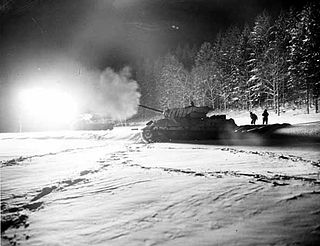 W
WThe Battle of Alsace was a military campaign between the Allies and the Nazis in Alsace, eastern France, from November 1944 to March 1945.
 W
WThe Battle of Belgium or Belgian Campaign, often referred to within Belgium as the 18 Days' Campaign, formed part of the greater Battle of France, an offensive campaign by Germany during the Second World War. It took place over 18 days in May 1940 and ended with the German occupation of Belgium following the surrender of the Belgian Army.
 W
WThe Battle of Bir Hakeim took place at Bir Hakeim, an oasis in the Libyan desert south and west of Tobruk, during the Battle of Gazala. The 1st Free French Brigade defended the position from 26 May – 11 June against much larger Axis forces of Panzerarmee Afrika/Armata Corazzata Africa. The Panzerarmee captured Tobruk ten days later but the delay imposed on the Axis offensive by the defence of the fortress influenced the cancellation of Operation Herkules, a plan for an Axis invasion of Malta. Rommel continued to advance and invaded Egypt, slowed by British delaying actions until the First Battle of El Alamein in July, where the Axis advance was stopped. Both sides used the battle for propaganda, Winston Churchill renamed the Free French as the Fighting French and Hitler called the French the second best fighters after the Germans.
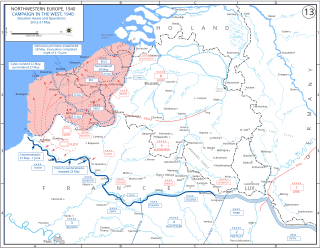 W
WThe Battle of Boulogne in 1940 was the defence of the port of Boulogne-sur-Mer by French, British and Belgian troops in the Battle of France during the Second World War. The battle was fought at the same time as the Siege of Calais, just before Operation Dynamo, the evacuation of the British Expeditionary Force (BEF) from Dunkirk. After the Franco-British counter-attack at the Battle of Arras on 21 May, German units were held ready to resist a resumption of the attack on 22 May. General der Panzertruppe (Lieutenant-General) Heinz Guderian, the commander of XIX Corps, protested that he wanted to rush north up the Channel coast to capture Boulogne, Calais and Dunkirk. An attack by part of XIX Corps was not ordered until 12:40 p.m. on 22 May, by which time the Allied troops at Boulogne had been reinforced from England by most of the 20th Guards Brigade.
 W
WThe Battle for Brest was fought on the Western Front during World War II. Part of the Allied plan for the invasion of mainland Europe called for the capture of port facilities, in order to ensure the timely delivery of the enormous amount of war materiel required to supply the invading Allied forces. It was estimated that the 37 Allied divisions to be on the continent by September 1944 would need 26,000 tons of supplies each day. The main port the Allied forces hoped to seize and put into their service was Brest, in northwestern France.
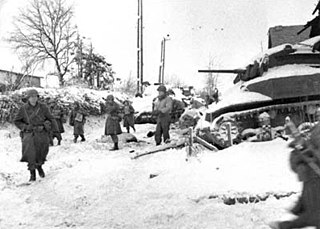 W
WThe Battle of the Bulge, also known as the Ardennes Counteroffensive, was the last major German offensive campaign on the Western Front during World War II, and took place from 16 December 1944 to 25 January 1945. It was launched through the densely forested Ardennes region of Wallonia in eastern Belgium, northeast France, and Luxembourg, towards the end of the war in Europe. The offensive was intended to stop Allied use of the Belgian port of Antwerp and to split the Allied lines, allowing the Germans to encircle and destroy four Allied armies and force the Western Allies to negotiate a peace treaty in the Axis powers' favor.
 W
WClearing the Channel Coast was a World War II task undertaken by the First Canadian Army in August 1944, following the Allied Operation Overlord and the victory, break-out and pursuit from Normandy.
 W
WThe Colmar Pocket was the area held in central Alsace, France, by the German Nineteenth Army from November 1944 to February 1945, against the U.S. 6th Army Group during World War II. It was formed when 6th AG liberated southern and northern Alsace and adjacent eastern Lorraine, but could not clear central Alsace. During Operation Nordwind in December 1944, the 19th Army attacked north out of the Pocket in support of other German forces attacking south from the Saar into northern Alsace. In late January and early February 1945, the French First Army cleared the Pocket of German forces.
 W
WOperation Compass was the first large British military operation of the Western Desert Campaign (1940–1943) during the Second World War. British, Indian, Commonwealth and Allied forces attacked Italian forces of the 10th Army in western Egypt and Cyrenaica, the eastern province of Libya, from December 1940 to February 1941.
 W
WThe Dover Strait coastal guns were British and German long-range coastal artillery pieces, on the English Channel coasts of Kent, England and the Pas-de-Calais, occupied France. The Strait of Dover is the narrowest channel between England and continental Europe. During the Second World War, both sides used their guns to bombard shipping in the Channel as well as coastal towns and military installations.
 W
WOperation Dragoon was the code name for the landing operation of the Allied invasion of Provence on 15 August 1944. The operation was initially planned to be executed in conjunction with Operation Overlord, the Allied landing in Normandy, but the lack of available resources led to a cancellation of the second landing. By July 1944 the landing was reconsidered, as the clogged-up ports in Normandy did not have the capacity to adequately supply the Allied forces. Concurrently, the French High Command pushed for a revival of the operation that would include large numbers of French troops. As a result, the operation was finally approved in July to be executed in August.
 W
WThe Siege of Dunkirk in World War II began in September 1944, when Allied units of the Second Canadian Division surrounded the fortified city and port of Dunkirk. The siege lasted until after the official end of the war in Europe. German units within the fortress withstood probing attacks and as the opening of the port of Antwerp was more important, the 21st Army Group commander, Field Marshal Bernard Montgomery, decided to contain but not capture Dunkirk with the 1st Czechoslovak Armoured Brigade. The fortress, commanded by Admiral Friedrich Frisius, eventually surrendered unconditionally to Brigadier General Alois Liška, the commander of the Czechoslovak brigade group, on 9 May 1945, a day after the surrender of Nazi Germany took effect.
 W
WThe Second Battle of El Alamein was a battle of the Second World War that took place near the Egyptian railway halt of El Alamein. The First Battle of El Alamein and the Battle of Alam el Halfa had prevented the Axis from advancing further into Egypt.
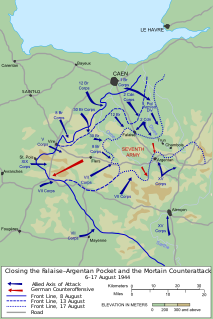 W
WThe Falaise Pocket or Battle of the Falaise Pocket was the decisive engagement of the Battle of Normandy in the Second World War. A pocket was formed around Falaise, Calvados, in which the German Army Group B, with the 7th Army and the Fifth Panzer Army were encircled by the Western Allies. The battle is also referred to as the Battle of the Falaise Gap. The battle resulted in the destruction of most of Army Group B west of the Seine, which opened the way to Paris and the Franco-German border for the Allied armies on the Western Front.
 W
WThe Battle of France, also known as the Fall of France, was the German invasion of France and the Low Countries during the Second World War. On 3 September 1939 France had declared war on Germany, following the German invasion of Poland. In early September 1939, France began the limited Saar Offensive. By mid-October, the French had withdrawn to their start lines. In six weeks from 10 May 1940, German forces defeated Allied forces by mobile operations, conquering France, Belgium, Luxembourg and the Netherlands, ending land operations on the Western Front until the Normandy landings on 6 June 1944. Italy entered the war on 10 June 1940.
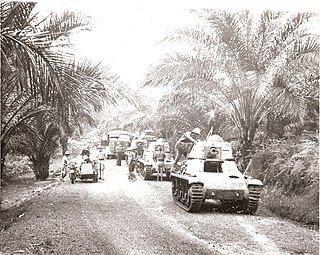 W
WThe Battle of Gabon, also called the Gabon Campaign, occurred in November 1940 during World War II. The battle resulted in the Free French Forces taking the colony of Gabon and its capital, Libreville, from Vichy French forces. It was the only significant engagement in Central Africa during the war.
 W
WThe Battle of Gazala was fought during the Western Desert Campaign of the Second World War, west of the port of Tobruk in Libya, from 26 May to 21 June 1942. Axis troops of the Panzerarmee Afrika consisting of German and Italian units fought the British Eighth Army composed mainly of British Commonwealth, Indian and Free French troops.
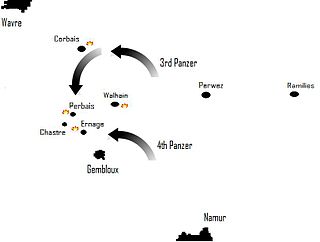 W
WThe Battle of Gembloux was fought between French and German forces in May 1940 during the Second World War. On 10 May 1940, The Nazi German Wehrmacht, invaded Luxembourg, The Netherlands and Belgium under the operational plan Fall Gelb. Allied armies responded with the Dyle Plan, intended to halt the Germans in Belgium, believing it to be the main German thrust. The Allies committed their best and most mobile to an advance into Belgium on 10 May and on 12 May, the Germans began the second part of Fall Gelb, the Manstein Plan an advance through the Ardennes, to reach the English Channel and cut off the Allied forces in Belgium.
 W
WThe Maquis des Glières was a Free French Resistance group, which fought against the 1940–1944 German occupation of France in World War II. The name is also given to the military conflict that opposed Resistance fighters to German, Vichy and Milice forces.
 W
WThe Battle of Hannut was a Second World War battle fought during the Battle of Belgium which took place between 12 and 14 May 1940 at Hannut in Belgium. It was the largest tank battle in the campaign. It was also the largest clash of tanks in armoured warfare history at the time.
 W
WThe Historiography of the Battle of France describes how the German victory over French and British forces in the Battle of France had been explained by historians and others. Many people in 1940 found the fall of France unexpected and earth shaking. Alexander notes that Belgium and the Netherlands fell to the German army in a matter of days and the British were soon driven back to the British Isles,But it was France's downfall that stunned the watching world. The shock was all the greater because the trauma was not limited to a catastrophic and deeply embarrassing defeat of her military forces – it also involved the unleashing of a conservative political revolution that, on 10 July 1940, interred the Third Republic and replaced it with the authoritarian, collaborationist Etat Français of Vichy. All this was so deeply disorienting because France had been regarded as a great power....The collapse of France, however, was a different case.
 W
WThe Italian invasion of Egypt was an offensive in the Second World War, against British, Commonwealth and Free French forces in the Kingdom of Egypt. The invasion by the Italian 10th Army ended border skirmishing on the frontier and began the Western Desert Campaign (1940–1943) proper. The Italian strategy was to advance from Libya along the Egyptian coast to seize the Suez Canal. After numerous delays, the scope of the offensive was reduced to an advance as far as Sidi Barrani and the engagement of any British forces in the area.
 W
WThe Battle of Kasserine Pass was a series of battles of the Tunisia Campaign of World War II that took place in February 1943. Covering Kasserine Pass, a 2-mile-wide (3.2 km) gap in the Grand Dorsal chain of the Atlas Mountains in west central Tunisia.
 W
WThe Capture of Kufra was part of the Allied Western Desert Campaign during the Second World War. Kufra is a basin and oasis group in the Kufra District of south-eastern Cyrenaica in the Libyan Desert. In 1940, it was part of the colony of Italian Libya Libia Italiana, which was part of Africa Settentrionale Italiana (ASI), which was established in 1934. With some early assistance from the British Long Range Desert Group, Kufra was captured by Free French Forces when the Italian and Libyan garrison surrendered after a siege from 31 January to 1 March 1941.
 W
WThe Battle of the Mareth Line or the Battle of Mareth was an attack in the Second World War by the British Eighth Army in Tunisia, against the Mareth Line held by the Italo-German 1st Army. It was the first big operation by the Eighth Army since the Second Battle of El Alamein 4 1⁄2 months previously. On 19 March 1943, Operation Pugilist, the first British attack, established a bridgehead but a break-out attempt was defeated by Axis counter-attacks. Pugilist established an alternative route of attack and Operation Supercharge II, an outflanking manoeuvre via the Tebaga Gap was planned. Montgomery reinforced the flanking attack, which from 26 to 31 March, forced the 1st Army to retreat to Wadi Akarit, another 40 mi (64 km) back in Tunisia.
 W
WThe Battle of Medenine was an Axis spoiling attack at Medenine in Tunisia on 6 March 1943. The operation was intended to delay an attack by the British Eighth Army on the Mareth Line. The British had been forewarned by Ultra decrypts of German wireless communications and rushed reinforcements from Tripoli and Benghazi before the Axis attack, which was a costly failure. General Erwin Rommel, the commander of Army Group Africa (Heeresgruppe Afrika), could not afford to lose forces needed for the defence of the Mareth Line and the effort was abandoned at dusk that day.
 W
WThe Maquis du Mont Mouchet were a group of French resistance fighters during the Second World War that were based at Mont Mouchet.
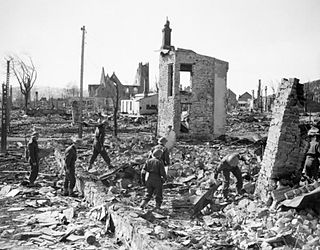 W
WThe Namsos campaign, in Namsos, Norway, and its surrounding area involved heavy fighting between Anglo-French and Norwegian naval and military forces on the one hand, and German military, naval and air forces on the other in April and early May 1940. It was one of the first significant occasions during the Second World War when British and French land forces fought the German Army.
 W
WThe Normandy landings were the landing operations and associated airborne operations on Tuesday, 6 June 1944 of the Allied invasion of Normandy in Operation Overlord during World War II. Codenamed Operation Neptune and often referred to as D-Day, it was the largest seaborne invasion in history. The operation began the liberation of German-occupied France and laid the foundations of the Allied victory on the Western Front.
 W
WThe Battle of the Netherlands was a military campaign part of Case Yellow, the German invasion of the Low Countries and France during World War II. The battle lasted from 10 May 1940 until the surrender of the main Dutch forces on 14 May. Dutch troops in the province of Zealand continued to resist the Wehrmacht until 17 May when Germany completed its occupation of the whole country.
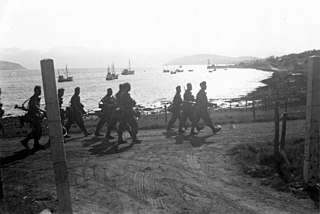 W
WThe Actions in Nordland were part of the 1940 Norwegian Campaign of World War II. They were a subsidiary part of the Allied attempt to recapture Narvik.
 W
WOperation Nordwind was the last major German offensive of World War II on the Western Front. It began on 31 December 1944 in Rhineland-Palatinate, Alsace and Lorraine in southwestern Germany and northeastern France, and ended on 25 January 1945. The German offensive was an operational failure, with its main objectives not achieved.
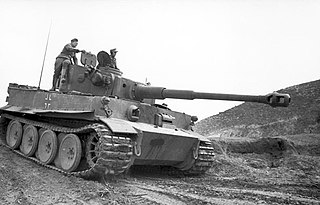 W
WUnternehmen Ochsenkopf also known as the Battle of Sidi Nsir and the Battle of Hunts Gap was an Axis offensive operation in Tunisia from 26 February to 4 March 1943, during the Tunisia Campaign of the Second World War. The offensive and a subsidiary operation Unternehmen Ausladung, was intended to gain control of Medjez el Bab, Béja, El Aroussa, Djebel Abiod and a position known as Hunt's Gap, between the British First Army and the Axis Army Group Africa. The offensive gained some ground, but none of the more ambitious objectives were achieved before the operation was called off, due to increasing losses of infantry and tanks, particularly the heavy Tigers. Unternehmen Ochsenkopf was the last big Axis offensive by the 5th Panzer Army before the final Allied offensive in April and May in which the Allies occupied Tunisia and took the surviving 250,000 Axis troops into captivity.
 W
WThe Battle of Port-en-Bessin also known as Operation Aubery took place from 7–8 June 1944, at a small fishing harbour west of Arromanches during the Normandy landings of World War II. The village was between Omaha Beach to the west in the U.S. V Corps sector, and Gold Beach to the east in the British XXX Corps sector. An objective during Operation Overlord, the fortified port was captured by No. 47 Commando of the 4th Special Service Brigade.
 W
WThe Raid on Sidi Haneish Airfield was a military operation carried out the night of 26 July 1942. A British Special Air Service unit commanded by Major David Stirling attacked a German-held airfield in Egypt during the Western Desert Campaign of Second World War. Several Luftwaffe aircraft used to ferry supplies to the Axis forces were destroyed or damaged with machine-gun fire and explosives. Axis front line units were diverted to reinforce the garrisons in the rear vulnerable to attack.
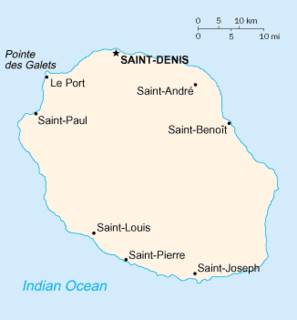 W
WThe Battle of Réunion or Liberation of Réunion was an amphibious landing and uprising which brought the island of Réunion onto the Allied side during the Second World War. The invasion was performed by the Free French Naval Forces (FNFL) destroyer Léopard on 28 November 1942, which toppled the administration loyal to the Vichy French regime and replaced it with a Free French administration.
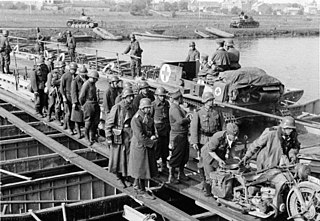 W
WThe Battle of Sedan or Second Battle of Sedan took place in the Second World War during the Battle of France in 1940. It was part of the German Wehrmacht's operational plan codenamed Fall Gelb for an offensive through the hilly and forested Ardennes, to encircle the Allied armies in Belgium and north-eastern France. German Army Group A crossed the Meuse river with the intention of capturing Sedan and pushing northwards towards the Channel coast, to trap the Allied forces that were advancing east into Belgium, as part of the Allied Dyle Plan.
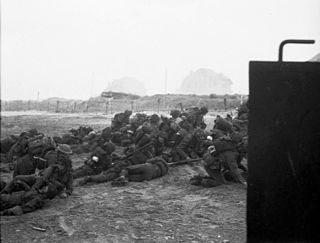 W
WSword, commonly known as Sword Beach, was the code name given to one of the five main landing areas along the Normandy coast during the initial assault phase, Operation Neptune, of Operation Overlord, the Allied invasion of German-occupied France that commenced on 6 June 1944. Stretching 8 kilometres (5.0 mi) from Ouistreham to Saint-Aubin-sur-Mer, the beach was the easternmost landing site of the invasion. Taking Sword was to be the responsibility of the British Army with sea transport, mine sweeping, and a naval bombardment force provided by the British Royal Navy as well as elements from the Polish, Norwegian and other Allied navies.
 W
WThe Battle of Troina was an important battle that took place between 31 July and 6 August 1943, as part of the Allied invasion of Sicily during World War II. Forces of the U.S. II Corps, part of the U.S. Seventh Army, under George S. Patton, engaged in fierce fighting around the town of Troina in the central portion of Sicily along the Caronie Mountains. The battle focused around the numerous hills and mountains surrounding Troina which the Germans had heavily fortified and used as bases for direct and indirect fire.
 W
WThe Run for Tunis was part of the Tunisia Campaign which took place during November and December 1942 during the Second World War. Once French opposition to the Allied Operation Torch landings had ceased in mid-November, the Allies made a rapid advance by a division-sized force east from Algeria, to capture Tunis and forestall an Axis build up in Tunisia and narrowly failed. Some Allied troops were fewer than 20 miles (32 km) short of Tunis by late November but the defenders counter-attacked and pushed them back nearly 20 miles (32 km), to positions which had stabilised by the end of the year.
 W
WThe Maquis du Vercors was a rural group of the French Forces of the Interior (FFI) (maquis) that resisted the 1940–1944 German occupation of France in World War II. The Maquis du Vercors used the prominent scenic plateau known as the Massif du Vercors as a refuge. Initially the maquis carried out only sabotage and partisan operations against the Germans, but after the Normandy Invasion on 6 June 1944, the leadership of an army of about 4,000 maquis declared the "Free Republic of Vercors," raised the French flag, and attempted to create a conventional army to oppose the German occupation.